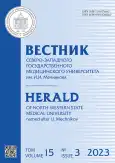New method for determining volume of intraoperative blood loss during burn treatment surgery
- 作者: Zinovev E.V.1,2, Vagner D.O.1,3, Chukharev A.E.1,4
-
隶属关系:
- Saint Petersburg Institute of Emergency Care named after I.I. Dzhanelidze
- S.M. Kirov Military Medical Academy
- North-Western State Medical University named after I.I. Mechnikov Saint Petersburg
- North-Western State Medical University named after I.I. Mechnikov
- 期: 卷 15, 编号 3 (2023)
- 页面: 25-32
- 栏目: Original study article
- URL: https://journal-vniispk.ru/vszgmu/article/view/249454
- DOI: https://doi.org/10.17816/mechnikov321450
- ID: 249454
如何引用文章
详细
BACKGROUND: Nowadays, there are numerous ways to assess the volume and minimize intraoperative blood loss; however, their effectiveness is subjective. To compare the effectiveness of blood-saving techniques, it is necessary to create new more reliable methods for determining intraoperative blood loss.
AIM: To develop a new technique for determining intraoperative blood loss in the surgical treatment of burn victims.
MATERIALS AND METHODS: In the course of the study, we have developed and proposed our own, original method for determining the volume of intraoperative blood loss, taking into account the indicators of hemoglobin and hematocrit as well as a differentiated calculation of the volume of circulating blood. This technique has been tested on 82 victims with deep burns of the II–III degree (International Classification of Diseases 10th Revision), who were admitted to the department of thermal lesions in the period from April 2021 to December 2021. The data obtained have been processed in the Microsoft Excel 2007 program as well as by generally accepted methods of nonparametric statistics.
RESULTS: The methods currently available have a large variability of results when performing the same intervention. The developed technique shows a stable relationship between the volume of blood loss and the area of the excised scab.
CONCLUSIONS: The data obtained allow to conclude that the new method for determining blood loss in burn victims appears to be a simple and effective method. The new technique will allow to find the most effective methods of minimizing blood loss during surgical necrectomies, which will reduce the need for additional hemotransfusions and promote earlier rehabilitation of burn treatment.
作者简介
Evgenii Zinovev
Saint Petersburg Institute of Emergency Care named after I.I. Dzhanelidze; S.M. Kirov Military Medical Academy
Email: evz@list.ru
ORCID iD: 0000-0002-2493-5498
SPIN 代码: 4069-2346
Scopus 作者 ID: 57208391963
Researcher ID: E-5656-2014
MD, Dr. Sci. (Med.), Professor
俄罗斯联邦, Saint Petersburg; Saint PetersburgDenis Vagner
Saint Petersburg Institute of Emergency Care named after I.I. Dzhanelidze; North-Western State Medical University named after I.I. Mechnikov Saint Petersburg
Email: 77wagner77@mail.ru
ORCID iD: 0000-0001-7241-4008
SPIN 代码: 1820-8818
MD, Cand. Sci. (Med.)
俄罗斯联邦, Saint Petersburg; Saint PetersburgAlexander Chukharev
Saint Petersburg Institute of Emergency Care named after I.I. Dzhanelidze; North-Western State Medical University named after I.I. Mechnikov
编辑信件的主要联系方式.
Email: chuharevae@gmail.com
ORCID iD: 0000-0001-6579-3863
SPIN 代码: 4504-5085
MD, postgraduate student
俄罗斯联邦, Saint Petersburg; Saint Petersburg参考
- Alekseev AA. The main statistical indicators of the work of medical organizations of Russia in providing specialized medical care to victims of burns in 2021. Meeting of the profile commission on combustiology of the Ministry of Health of Russia together with the Plenum of the All-Russian public organization “Association of combustiologists “World without burns”. 29.10.2020. (In Russ.)
- Ar’ev TYa. Termicheskie porazheniya. Leningrad: Meditsina; 1966. 704 p. (In Russ.)
- Bogdanov SB, Afaunova ON. Modern treatment for extremities borderline burns. Innovative medicine of Kuban. 2016;2:22–26. (In Russ.)
- Vikhriev BS, Burmistrov VM. Ozhogi: Rukovodstvo dlya vrachei. 2nd ed. Leningrad: Meditsina; 1986. 272 p. (In Russ.)
- Murazyan RI, Maksimov PI. Extensive necrectomy in the treatment of deep burns. Surgery. 1980;5:41–45. (In Russ.)
- Chmyrev IV. Zavisimost’ letal’nosti obozhzhennykh ot taktiki lecheniya. Bulletin of the Russian Military Medical Academy. 2011;3(35):63–65. (In Russ.)
- Chmyrev IV, Skvortsov YR, Kichemasov SH, et al. The use of ultrasound in the surgical treatment of deep burns. Bulletin of St. Petersburg University. 2011;2:52–67. (In Russ.)
- Yarugsky EE. Thermal burns. Tashkent: Medicine of the Uzbek SSR; 1987. 151 p. (In Russ.)
- Budny PG, Regan PJ, Roberts AHN. The estimation of blood loss during burns surgery. Burns. 1993;19(2):134–137. doi: 10.1016/0305-4179(93)90036-8
- Gross JB. Estimating allowable blood loss: corrected for dilution. Anesthesiology. 1983;58(3):277–280. doi: 10.1097/00000542-198303000-00016
- Housinger TA, Lang D, Warden GD. A prospective study of blood loss with excisional therapy in pediatric bum patients Trauma. 1993;34:262–263. doi: 10.1097/00005373-199302000-00015
- Janezic T, Prezelj B, Brcic A. et al. Intraoperative blood loss after tangential excision of burn wounds treated by subeschar infiltration of epinephrineю Scand J Plast Reconstr Hand Surg. 1997;31(3):245–250. doi: 10.3109/02844319709051538
- Schorn MN. Measurement of blood loss: review of the literature. J Midwifery Womens Health. 2010;55(1):20–27. doi: 10.1016/j.jmwh.2009.02.014
- Warden GD, Saffle JR, Kravitz M. A two-stage technique for excision and grafting of burn wounds. Trauma. 1982;22(2):98–103. doi: 10.1097/00005373-198202000-00004
补充文件











